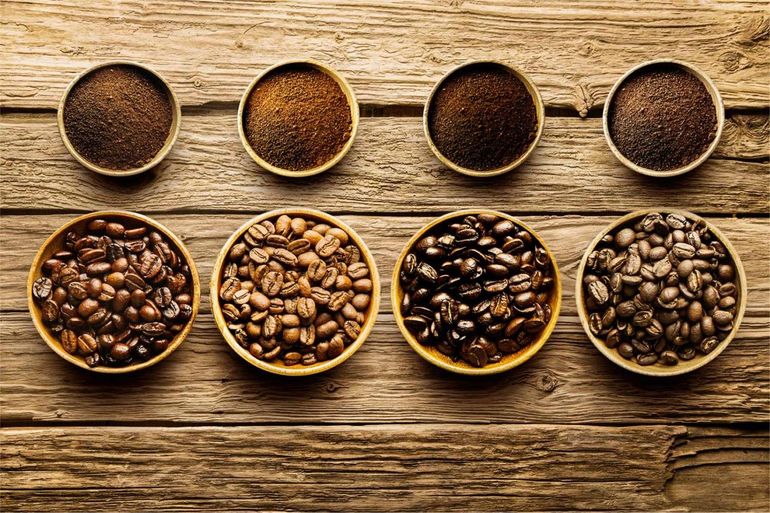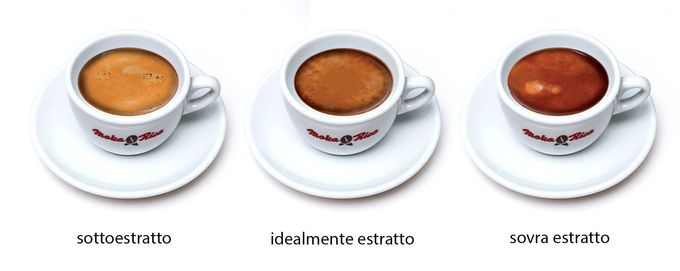THE PERFECT ESPRESSO
The espresso must be creamy, full-bodied, aromatic, and prepared with an industrial machine that modern technology has perfected; yet making a good espresso remains an art that few possess.
Watching a barista who, with quick and effortless gestures, prepares one espresso after another, one might think it is an easy task, practically within everyone's reach.
However, behind those almost mechanical movements lies knowledge, study, technique, and a great deal of precision, as well as cleanliness, attention to detail, and meticulous care for the product and the machines used to prepare it.
Many are indeed the factors that influence the success of a good espresso.


THE BLEND
All the most sophisticated technique and a skilled barista will never be able to extract a good espresso from a poor blend. Whether a blend or a single origin, the coffee must be good, that is, pleasant, sweet, fragrant, aromatic, and leave a pleasant and lasting aftertaste. Let us remember that after drinking a good coffee, we should always feel the desire to savour another. Within the limits of local habits and tastes, the coffee beans should be roasted just right because if too dark, it will be more bitter, and if too light, it will be excessively acidic.
STORAGE
Coffee beans can be stored for a long time in the original packaging, whether a bag or a jar, but once the packaging is opened, the product deteriorates rapidly. To preserve it better, after use, it should be placed in an airtight container and kept in the refrigerator. The same technique can be adopted at home to store ground coffee, but in any case, even with this precaution, ground coffee is about fifty times more perishable than whole beans. This is because the grinding process significantly increases the surface area of the coffee exposed to atmospheric oxidation. A barista should never store ground coffee in the doser for more than a few hours.
THE DOSER
THE GRINDER
The standard bar grinder consists of two flat grinding wheels stacked on top of each other, whose distance can be adjusted to choose the right coarseness of the powder. The grind setting should also be adjusted several times a day, depending on variations in atmospheric humidity, especially in areas with variable climates: high humidity requires a coarser grind; otherwise, the percolation will be slow and hindered, and the product will be over-extracted; a lack of humidity requires a finer grind. It is advisable to grind only a small amount of coffee at a time so that the product is always fresh: it should just cover the fins of the doser. Additionally, flat burr grinders operate at high speeds, and prolonged operation could overheat the coffee, giving it an unpleasant taste of smoke and burnt. The grinding wheels should be replaced approximately every 400 kilos of coffee. In the case of very light roasted coffee, the wear of the wheels is faster, and therefore they should be replaced more frequently.
THE DOSER
The volumetric doser does not weigh the coffee but measures a certain volume, which must be set and checked with great accuracy and at certain intervals. The ideal dose would be 7 grams for a single cup and 14 grams for two cups. In the absence of sensitive scales, the calibration of the doser is done by weighing ten doses and adjusting to seven grams. Cleaning the grinder is very important because coffee residues can go rancid and ruin the taste of the product.
THE MACHINE
In the modern automatic espresso machine, the heart consists of the boiler in which the water is heated. It is important to remember that the water from the boiler is not used for making coffee; instead, it is dispensed from the designated tap and will be used for tea and other purposes. In the upper part of the boiler, steam is formed, which, through another tap on the machine, will be used to heat milk and other liquids. The water for the coffee, pushed by a pump at a pressure of 9 BAR (atmospheres), passes through a heat exchanger inside the boiler where it is heated and maintained at the right temperature of about 90°C.
PREPARATION
After filling the filter from the doser, the coffee should be pressed with a force of 10-20 kilos. Generally, a good operator will adjust by pressing the coffee in a way that compensates for any small defects in the grinding. Before attaching it to the machine group, the edge of the portafilter should be cleaned, as coffee residues could limit the closure (resulting in a loss of pressure) and form deposits on the seal, which could deteriorate more quickly. The espresso should flow out smoothly and in a “mouse tail”; the cup should be warm but not scald the customer's lips.
MAINTENANCE
Maintenance is fundamental to achieving a perfect espresso: the grinder's hopper must be cleaned regularly to remove any traces of fat. The inside of the grinder should be brushed carefully to eliminate all residues, while the doser should be cleaned with a brush. Every evening, the filters from the portafilters of the machine must be removed and washed; the attachment area should be cleaned carefully with a metal brush. It is preferable to leave the machine on overnight, especially to avoid excessive limescale build-up; in this regard, it is very important to frequently check the water softener. Limescale deposits limit the flow of water, lowering the temperature and compromising the quality of the extraction. By extraction, we mean a rapid process established according to the degree of grinding, water temperature, pressure, and contact time between the water and the powder.
THE PARAMETERS OF ESPRESSO
Espresso refers to a small cup of concentrated coffee, extracted from freshly ground coffee beans, and should correspond to the following average parameters:
- Quantity of coffee needed: 7g
- Temperature of the water: 90°C
- Pressure of the water: 9 BAR
- Compression in the filter: approximately 15 kg
- Extraction time: 25 seconds
- Quantity in the cup: 25 ml
- Temperature of the empty cup: 60°C






